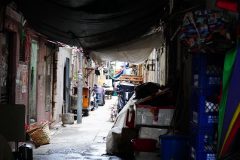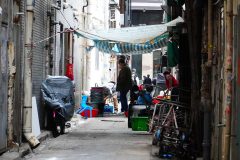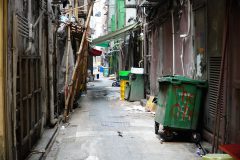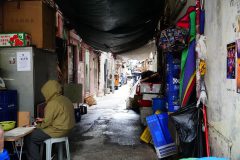YouTube Link: https://youtu.be/u5eONwWthoo
Transcript:
C= Candy
V=Valerie
C: “I’ve known from an early age; money is a dream. It’s a fantasy. It’s also a future” (film quote)
V: Oh, it seems that you are having a hard time trying to make ends meet!
C: I’m not talking from my own perspective; it is a quote from the film Little Cheung released in 1999.
V: Oh yes indeed! Do you remember that we watched that movie together during the semester break?
C: Yes, perhaps we should also introduce this wonderful film to our listeners.
C: I am Candy.
V: I am Valerie.
C+V: Welcome to our podcast
V: Little Cheung, directed by Fruit Chan, revolves around a coming-of-age boy named Little cheung and fan, a girl who was being smuggled to Hong Kong. Located in a local chaa chen teeng, it introduces other characters successively, including a short-tempered yet conscientious father, a mahjong addict mother, a caring grandmother who is a former opera singer and a hard-working domestic maid.
C: The uncertain world amidst returning of Hong Kong to China is viewed and narrated by the little boy which also featured scenes of Little Cheung facing the partings of his grandmother’s death, his maid’s return to her homeland and the ending scene in which Fan’s jeopardized identity was finally uncovered with her sitting in the police patrol car.
V: The most striking feature of this movie is bringing the theme of juxtaposition, a shift in social fabric, family dynamics and materialism through the eyes of a naive, courageous boy. A subtle incorporation of political elements in the movie can be spotted, yet the focus today is not Hong Kong China relationships, but Hong Kong landmarks shown in the movie.
Question 1
V: Candy! I knew that the film was first screened at 1999. Which of the iconography of Hong Kong culture do you think will disappear in the next 10 years?
C: Yes, this film brings us a lot of insight into Hong Kong culture. As a part of the Z-generation, I found that the street display, constructions and activities of residents were quite different from nowadays. Some of the Hong Kong iconography culture like neon lights and outdoor advertisement boards have already been removed due to safety issues.
For the next culture that will disappear in the next 10 years, I think alleyways will be one of them. In the film, after ah fun asked for a job at Little Cheung’s father chaa chen teeng and was rejected, Little Cheung followed her and saw that she was washing dishes at there; and later scenes shown that she lived there with her entire family, alleyway was a “secret” like location for Little Cheung to find her and escape away from his father.
Question 2
V: I agreed that the alleyways acted as spatial characters in the film which not only acted as a backstage for undocumented people, but its junction also acted as a threshold. Since it has some special meanings, I want to know why you think it will be vanishing? Is there any sign of its disappearance in the near future that we can observe?
C: The main reason that I think it will vanish and as a sign of its disappearance is that, in “Little Cheung”, old Hong Kong was not yet developed, everything seems traditional, e.g. residents ordered chaa chen teeng every day instead of Western restaurants. However, Hong Kong, as an international city nowadays, has rebuilt many old buildings and it is difficult to identify the filming location. Apart from the street serving as a connection with the community and worldwide, alleyways act as the backstage of that. As I think the development of Hong Kong is better than the past, to have more spaces to serve as a connection and a place to express our city, alleyways may be replaced by streets, which indicate its disappearance.
Although alleyways serve as backstage for undocumented people, I think that homes are not that safe for present people to live in—since the placement of rubbish and unknown things will bring potential safety risks, e.g. it may affect the health, and the appearance of the mouse may even bring hygiene issues. Moreover, its junction as a threshold also reflected that Ah Fan and Little Cheung were people in two different worlds. Compared with Little Cheung, Ah Fan did not have a home and was always not sure about her future, alleyways showed the dark side of people who did not get the chance in Hong Kong. However, I think these dark sides should be replaced by the bright side now because HK is a city that is full of chances and opportunities; and potential issues may cause alleyways to disappear.
Question 3
C: I knew that you have observed many things when watching the film, do you have any ideas of alleyways’ past and present? What purpose/s does it serve?
V: In the movie, alleyways are part of Little Cheung’s and Fan’s domestic settings. There is a rendering of scenes through alleyways featuring scenes like Fan washing dishes, their journey across the alleyway during their food delivery. It serves as a cohesive framing device that highlights their interactions and experiences by the recurring usage. Viewers witness the cascading process of two innocent children developing their delicate friendship or even romantic relationship as the movie progresses, mostly taking part in a dingy alleyway. The alleyway was shabby, dim and the seclusive nature made it uncared-for, which echoes the furtive identity of Fan and the two young souls facing an uncertain and grimy future under times of political instability and an overwhelming identity crisis fostered in their heart. Therefore, the echoing between the exterior environment and the interior mind shouldn’t be overlooked. Even though some may argue about the truthfulness of the plot on reflecting true everyday footage of Hongkongers in the 90s, it generally presents a neo-realism style by deliberately filming in the authentic alleyways on street in grass-root houses, to create a hk style. The ultimate purpose is to provoke exterior and interior visualization and establish a two-way exchange of ideas between the movie production team and the viewers.
Question 4
C: Uhmm… if it disappears, who do you think will be affected? What are their feelings and attitudes toward this?
V: When considering the contemporary settings of Hong Kong, alleyways were not as commonly seen like in the movie. In fact, they are regarded as obnoxious and unwanted because most of the time, they were of poor maintenance and hygiene. In addition, City dwellers hid there to do something informal or illicit, such as smoking, murder, etc. contributing to an overall negative perception. As a result, I will say not many of us common folks will show concern if they no longer exist. On the other hand, when you consider the movie protagonists, Little Cheung and Fan, the disappearance of alleyways may cause a fragmentation of the emotions and relationships, coming with the loss of the collective memory. Throughout the film, audiences witness the ambiguous identity of Fan and her family possessed, seemingly living in HK as a borrowed space– an exotic space where they undergo operations, which is an idea proposed by Michel de Certeau. Those operations are visible mainly in alleyways when they are happily living their everyday life watching Television, developing neighborship in their community, playing with each other, enjoying their family time, etc. Therefore, it serves as a time capsule connecting Fan and Little Cheung. Just as the old saying goes, “distance may make you forget one person, but the memory always stays”. As they grow up, memories fade away. Once the alleyway that contains their memories disappears, they may feel sadness, homesickness, disappointment and a mixture of negative emotions.
Question 5
V: Getting to know that the character’s experiences of negative feelings, is there anything being done about its impending disappearance?
C: Although characters may have negative feelings, I think how to keep the collective memories and connection between residents are more important. Therefore, about its impending disappearance, reconstruction of buildings and cleaning of it are all being done. Even though the reconstruction may change the original outlook of location, memories should be created continuously while saving the past time in their mind. Alleyways that changed to other forms under reconstruction projects, like stores, etc., can help residents to connect with each other since this creates more choices locations for them to have gathering. Thus, they can continue to create new memories that can bring positive feelings to them. Moreover, the disappearance of alleyways can bring the bright side to a city, as cleaning is a way to solve the potential issues, which helps to create a better living environment for residents, I believe residents’ negative feelings can be covered by positive feelings.
C+V: This is the end of our podcast. Thank you for listening!
Kan Nok Ming Valerie 3036233483
Ye Tsz Yu Candy 3036075702




